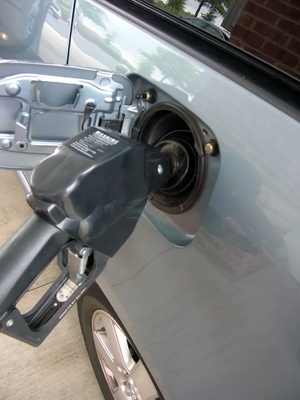
Biodiesel is a type of diesel fuel that emits fewer pollutants that petroleum-based diesel fuels. It is made from vegetable oil, animal fat or recycled restaurant greases. Biodiesel is available in its pure form, B100, which is 100 percent biodiesel or a blended form that is mixed with petroleum fuels. Biodiesel is celebrated because it is non-toxic, biodegradable and is made from renewable sources. It can be used in most diesel engines, but older engines might not be able to handle all blends of biodiesel. Check your owner's manual for the blend that is right for your vehicle.
Biodiesel fuel has a higher gel point than petroleum-based diesel fuels. This means that the fuel turns to a slushy or gel-like consistency in cold temperatures. 100 percent biodiesel fuel (B100) turns to a gel at 32 degrees Fahrenheit, while B20, a blend of 20 percent biodiesel and 80 percent regular diesel fuel turns to gel at 7 degrees Fahrenheit. Biodiesel's gel point is lowered when a lower percentage of biodiesel is contained in the product. Auto makers do not warranty vehicles if you use a blend above B5 (5 percent biodiesel) because of the potential damage of the high gel point. To avoid this type of damage, do not run biodiesel fuel in your vehicle in cold climates. If you must run biodiesel, use a fuel blend and keep your diesel engine running, which is a common practice for vehicles that use regular diesel fuel in cold climates.
Biodiesel will degrade rubber components used in fuel hoses and pump seal systems over time. Higher-percentage blends of biodiesel will degrade these components even faster. Parts made with natural or butyl rubbers will become sticky and fall apart if allowed to come in contact with pure biodiesel or high-percentage biodiesel blends. This is an especially big problem in vehicles made before 1994, when elastomers and natural rubber hoses were commonly used. After 1994, most engine manufacturers began using synthetic fuel lines and seals, so degradation by biodiesel shouldn't be a problem.
Biodiesel has a much shorter shelf life than petroleum-based diesel fuel and gasoline. Six months is the most commonly estimated shelf life for biodiesel. After this point in storage, your fuel should be tested before being put in a vehicle. The best option is to purchase freshly made biodiesel fuel in smaller quantities to avoid having to store it for long periods of time.
Biodiesel fuel is currently more expensive than petroleum-based diesel fuel and is less commonly available. You can't just pull up to a gas station and expect to find pure biodiesel available at the pumps, although more and more gas stations are making biodiesel blends available to consumers. If you can't find biodiesel in your area, you can make it yourself using recipes that are easy to find on the Internet. Biodiesel is made using renewable sources like vegetable oil and animal fats. The problem with using vegetable oil to make biodiesel is that it uses so much of the vegetable supply for production. The use of vegetables for biodiesel increases the demand for vegetables, which then increases the cost of these vegetables for the consumer.